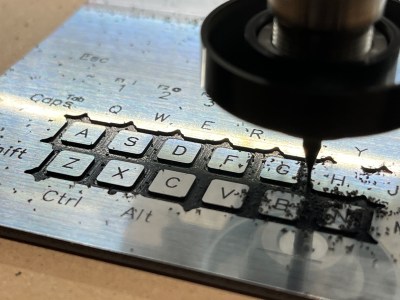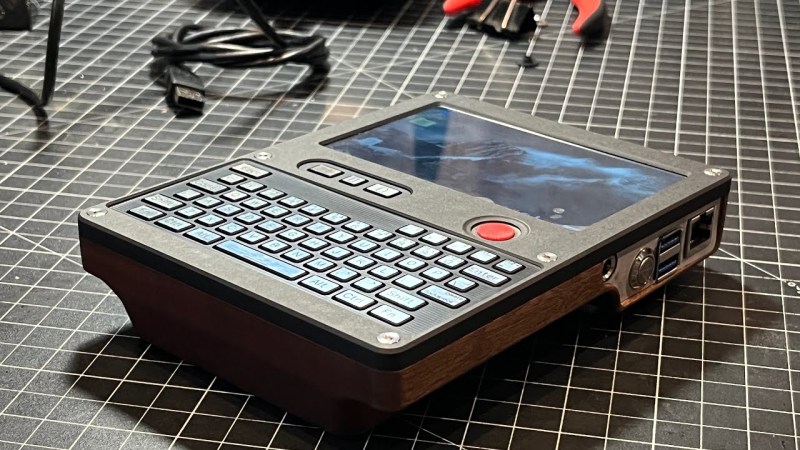[Nicholas LaBonte] shows off a Cyberdeck Handheld that demonstrates just how good something can look when care and attention goes into the design and fabrication. He wanted to make something that blended cyberpunk and nautical aesthetics with a compact and elegant design, and we think he absolutely succeeded.
On the inside is a Raspberry Pi and an RTL-SDR. The back of the unit is machined from hardwood, and sports a bronze heat sink for the Raspberry Pi. The front has a prominent red PSP joystick for mouse input and a custom keyboard. The keyboard is especially interesting. On the inside it’s a custom PCB with tactile switches and a ATmega32U4 running QMK firmware — a popular choice for DIY keyboards — and presents to the host as a regular USB HID device.

How did he make those slick-looking keys? It’s actually a single plate that sits between the front panel and the switches themselves. [Nicholas] used a sheet of polymer with a faux-aluminum look to it and machined it down, leaving metal-looking keys with engraved symbols as tabs in a single panel. It looks really good, although [Nicholas] already has some ideas about improving it.
On the right side is the power button and charging port, and astute readers may spot that the power button is where a double-stack of USB ports would normally be on a Raspberry Pi 5. [Nicholas] removed the physical connectors, saving some space and connecting the USB ports internally to the keyboard and SDR.
As mentioned, [Nicholas] is already full of ideas for improvements. The bronze heat sink isn’t as effective as he’d like, the SDR could use some extra shielding, and the sounds the keyboard ends up making could use some work. Believe it or not, there’s still room to spare inside the unit and he’d maybe like to figure out a way to add a camera, GPS receiver, or maybe a 4G modem. We can’t wait! Get a good look for yourself in the video, embedded below.
















This is awesome. Love the custom key board. Wish I had this case and screen!
I want this!
Looks amazing! I want to make one!
Love the fact that the creator decided to take the harder route and make their own keyboard instead of putting in a cheap plastic commercially available one. The results is spectacular
Great concept but it seems a bit thick. I’m not suggesting you shoot for the iPhone level of thinness but a double stack of USB ports is excessively thick.
I think this project would really be incredible with a compute module and a custom PCB to hold it.
This PCB could have all the peripherals that one might want.
I’m working on this right now – I’ve got a Pi CM4 on a Waveshare CM4-Nano-b baseboard, which has the same footprint as the CM4. It has Ethernet (which I’ll be removing because the jack is just too thick), mini-HDMI, one USB 2.0, DSI, CSI, and an audio jack. If I like it, I may make my own baseboard so that I can have USB 3 as well, in place of the Ethernet.
The main challenge I’m having is that I can touch type 100 WPM on keyboards down to about 16mm key spacing, but only thumb-type about 10 WPM on a Blackberry style 8mm keyboard. So to make it pocketable, I want to add a VERY thin folding keyboard so it can fold down to about the size of a smartphone, though it will still probably end up at 19mm thick. I’ve been using this computer with a BT mini-keyboard and a 4.3″ QLED/capacitive touch display, and it’s compact enough, but it’s just too painful for me to type that slowly.
By the way, why CM4 instead of CM5? Mainly power consumption. This combo takes about 2.7 Watts (about 3 hours on a 2.5 A-hr Li-poly battery) when watching YouTube videos on WiFi, where a CM5 would jack that up to about 5 W.
Seems fine to me – as long as the point was not to make a pocket sized, as then its a failure even for most if not all of my giant pockets.. But it isn’t too thick to be comfortable to hold (at least it looks nice on that front), and by being that bit thicker still has really decent I/O for a hand held.
I do agree with the other commenter than a compute module version could be even better, as so much more flexible as a brain box. But I also really like these sort of cases that use a regular Pi too – that custom keyboard PCB is pretty modular and useful for your other projects (probably anyway), but if it had also been the CM carrier board as it might well have been when you go down the CM route suddenly that effortless modularity is reduced.
The custom engraved keys look fantastic, I’ll have to give that a try on a future project!
That’s one clean keypad.
This looks like that it turned out really nice. Quite a step up from the clockworkPi uConsole that I dabble with.
Great looking build. And that’s a really nice trick with the Gravotech Metallex. I need to step away from the 3D printers and CO2 laser and give the CNC mill more love.
I wonder if interposing a thin sheet of rubber between the keycap layer and the Richlite will help the clackiness and also provide a seal against dirt intrusion.
It’s beautiful. Can I use it to play MP3s?
it’s gorgeous. from the right angle, it looks like an answering machine my dad bought in the mid 1980s.
too bad it won’t be used for anything
Don’t hold back, why won’t it be used for anything?
That is a really cool case and keyboard. Its nice to see something that isn’t 3D printed for a change, and I say this as someone with a 3D printer.